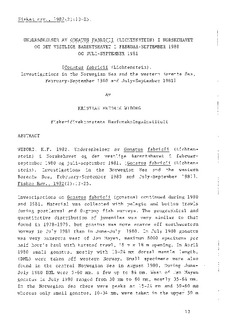| dc.description.abstract | Investigations on Gonatus fabricii (gonatus) continued during 1980
and 1981. Material was collected with pelagic and bottom trawls
during postlarval and 0-group fish surveys. The geographical and
quantitative distribution of juveniles was very similar to that
found in 1978-1979, but gonatus was more scarce off northwestern
Norway in July 1981 than in June-July 1980. In July 1980 gonatus
was very numerous west of Jan Mayen, maximum 8000 specimens per
half hour's hau1 with Harstad trawl, 18 m x 18 m opening. In April
1980 small gonatus, mostly with 10-24 mm dorsal mantle length,
(DML) were taken off western Norway. Small specimens were also
found in the central Norwegian Sea in August 1980. During June-
July 1980 DML were 5-60 mm, a few up to 84 mm. West of Jan Mayen
gonatus in July 1980 ranged from 30 mm to 80 mm, mostly 35-64 mm.
In the Norwegian Sea there were peaks at 15-24 mm and 50-60 mm
whereas only small gonatus, 10-34 mm, were taken in the upper 50 m
in July 1981. Larger gonatus, DML 126-250 mm, were only taken in
deeper layers (400-550 m) or in bottom trawl hauls near Jan Mayen.
Stomach contents of juvenile gonatus were dominated by amphipods,
mainly Parathemisto sp. Copepods, chaetognaths, krill and Sebastes
larvae were also identified. Larger gonatus had eaten Maurolicus
muelleri and small gonatus.
The study of growth rings in the statoliths has been continued
using a microscope with 1000 x enlargement. Earlier countings have
been revised. Near Jan Mayen, gonatus with DML 35-77 mm had
204-380 growth rings, but no correlation was observed between
lengths and number of rings. In the Norwegian Sea, gonatus with
DML 14-24 mm had 100-116 rings, DML 30-72 mm 172-229 rings, and
159-250 mm 287-330 rings. If the rings represent days, the largest
specimens are less than one year old.
As gonatus grow larger, they leave the upper water layers, and
those with the highest growth potential may leave first. They
probably also change their feeding habits to larger and more
nutritious organisms such as fish and squid. More data on age and
growth, especially from larger gonatus, are needed to get
reliable information. | en |
